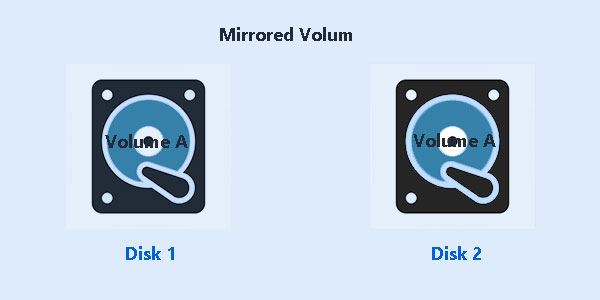What is mirrored volume? This article shows what mirrored volume is and how to create it with Disk Management or MiniTool Partition Wizard.
A mirrored volume is a fault-tolerant dynamic volume. It provides data redundancy by using two copies of volume or copying data stored on the volume. All data written into mirrored volume will be written in two mirrors which lie in the separate physical disk.

1.Overview
If one physical disk fails, the data on this failed disk is unavailable, but system can continue to run by using good disk. When one mirror of the mirrored volume fails, this mirrored volume must be suspended in order to make the other mirror become a volume with an independent drive letter. Then, you can create new mirrored volume in other disks. The available space of the new mirrored volume should be the same as or greater than that of previous good mirrored volume. When you create mirrored volume, you had better use two disks whose size, model and manufacturer are the same with each other.
System performance may be degraded because of dual writing operations. The duplex mode is used for many mirrored volume configurations. In this mode, each disk in mirrored volume has its own independent disk controller. Duplex mirrored volume has the best data reliability, because the whole input and output ( I/O ) subsystem is copied. This means that if one disk controller fails, other controllers ( and disks on them ) will continue running properly. If duplex controller isn’t used, the failed controller will make both mirrors in mirrored volume inaccessible. They can be accessed until the failed controller is replaced.
Almost any volume can be mirrored, including system and boot volumes. Later, you can’t enlarge the size of mirrored volume by extending it. On Itanium-based computers, you can’t mirror extensible firmware interface ( EFI ) system partition on GUID partition table ( GPT ).
When you mirror system volume or boot volume, a separate controller will be used on each disk in mirrored volume. This can make system configuration has better fault tolerance. This way allows system to work properly after hard disk or disk controller fails. When you create mirrored volume, you had better use two hard disks whose size, model and manufacturer are the same with each other. If you use a duplex technology, especially when you plan to mirror the system volume or boot volume, you are recommended to use the same disks and controllers.
When you mirror system volume, you should keep testing to make sure that you can start OS from every mirror when a certain disk fails. Users should always use the same disk and controller in order to avoid appearing boot problem.
At present, mirrored volume is widely used in simple serving systems which don’t use hardware RAID.
2.Creating Mirrored Volume
We’d like to take Windows Server 2003 as an example to introduce a method for creating mirrored volume based on simple volume:
Step 1: click “Disk Management ” in “ Computer Management ” and then right click the simple volume to which mirror will be added. Next, choose “ Add Mirror Volume ” command in the pop-up menu.
Step 2: you can open “ Add Mirror Volume ” dialog box. The “ Disk ” list will shows there is enough unallocated space on dynamic disk in the current system for us to create mirror. You may choose the dynamic disk you will use and then click “ Add Mirror Volume ” button.
Step 3: you may return to “ Disk Management ” interface. The system will start to synchronize content of the original simple volume and its copy. The time needed in this process mainly depends on data size of the simple volume and system performance. To be specific, users can see the percentage when synchronization is being carried out.
After synchronization is completed, the mirrored volume will show “ Healthy ” information.
Top recommendation: Want to know other ways to create mirrored volume? MiniTool Partition Wizard offers “Create Volume” feature to help you create dynamic disk volumes including Simple Volume, Spanned Volume, Striped Volume (Raid 0), Mirrored Volume (Raid 1) and Raid-5.